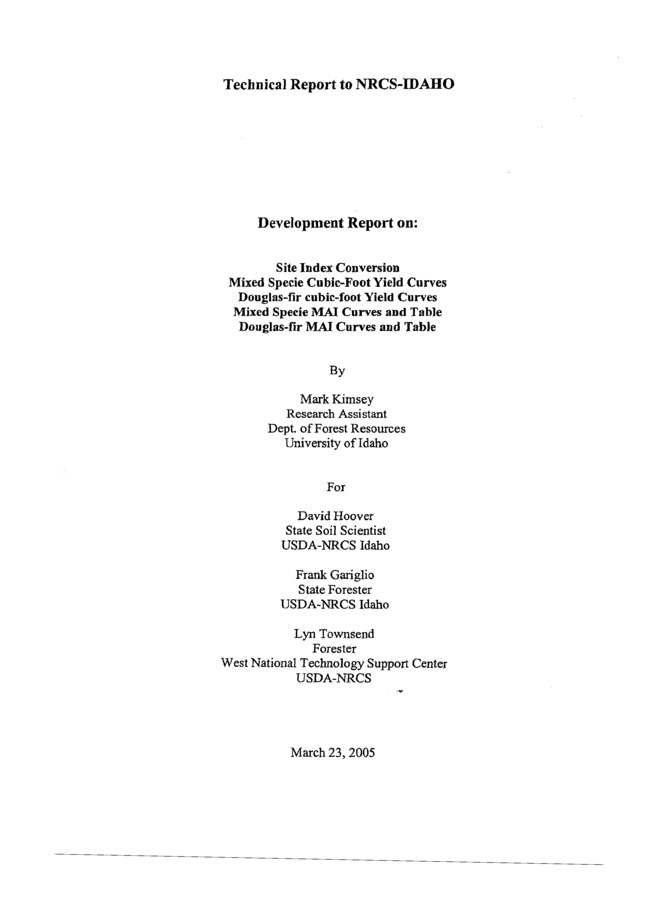PDF
Site Index Conversion, Mixed Specie Cubic-Foot Yield Curves, Douglas-fir cubic-foot Yield Curves, Mixed Specie MAI Curves and Table, Douglas-fir MAI Curves and Table Item Info
- Title:
- Site Index Conversion, Mixed Specie Cubic-Foot Yield Curves, Douglas-fir cubic-foot Yield Curves, Mixed Specie MAI Curves and Table, Douglas-fir MAI Curves and Table
- Creator:
- Kimsey, M.
- Date Created (ISO Standard):
- 2005-03-23
- Description:
- The current collection and dissemination of ESI forest plot information regarding Psuedotsuga menziesii var. glauca in north Idaho relies entirely on a method developed by P.H. Cochran. The incorporation ofthe Cochran method was introduced to NRCS Idaho from NRCS Oregon with Technical Note 190-VI. Development of yield and site index curves by Cochran was based entirely on forest stands located on the eastslopes ofthe Cascade Range and Blue Mountains ofeastern Oregon/southeast Washington. Cochran's proposed site index and yield curves were well developed and suited for the forested landscapes used in his modeling efforts. However, forest stands ofnorth Idaho and northwestern Montana are often dissimilar to their counterparts ofthe Cascades and Blue Mountains. This dissimilarity will inherently create significant predicted site index and yield error when using the Cochran method in north Idaho. Furthermore, there were very few Cochran research plots established on cedarlhemlock habitat types. Consequently, volume and site index estimates generated by the Cochran method will not reflect north Idaho productivity on these more climax habitat types. Several USDA-USFS research projects specifically developed site index and yield curves for north Idaho. Research papers INT-347 (R.A. Monserud, 1985) and INT-394 (A. Stage et aI., 1988) address these topics. Forest stands used to develop these models were located north from Grangeville to Porthill, Idaho and east to Libby, Montana. Most private and state forest management entities ofnorth Idaho utilize the Stage and Monserud models for reporting yield and site index. This creates a communication breakdown between the NRCS and other forest management entities. Standardization of yield and site index reports by the NRCS is needed not only to prevent this from occurring, but also to improve rotation estimates, carbon sequestration estimates, and other natural resource interpretations. Bringing the data up to consistent and accurate standards would improve the usability and acceptance of the NRCS Idaho soil survey product.
- Subjects:
- research data modeling forest management statistics
- Source:
- Kimsey, M.J. 2005. Development Report on: Site Index Conversion Mixed Specie Cubic-Foot Yield Curves; Douglas-fir Cubic-Foot Yield Curves, and Mixed Specie MAI curves and Table and Douglas-Fire MAI Curves and Table. Mean Annual Increment Conversions for Cochran to Monserud Timber Productivity Data. Technical Report. USDA-Natural Resources Conservation Service - IDAHO, Boise, ID.
- Source Identifier:
- Site_Index_Conversion_Mixed_Species_and_DF_Cubic_Foot_Yield_Curves_MAI_Curves_and Table_IFTNC_03_2005
- Type:
- Text
- Format:
- application/pdf
Source
- Preferred Citation:
- "Site Index Conversion, Mixed Specie Cubic-Foot Yield Curves, Douglas-fir cubic-foot Yield Curves, Mixed Specie MAI Curves and Table, Douglas-fir MAI Curves and Table", Intermountain Forestry Cooperative, University of Idaho Library Digital Collections, https://www.lib.uidaho.edu/digital/iftnc/items/iftnc4848.html
Rights
- Rights:
- This document is provided by the University of Idaho Library for use by University of Idaho students, staff, and faculty. All rights to the document linked from this metadata belong to the author, rights holder, and/or provider. For more information contact The Intermountain Forestry Cooperative, https://www.uidaho.edu/cnr/ifc
- Standardized Rights:
- http://rightsstatements.org/vocab/InC-EDU/1.0/

